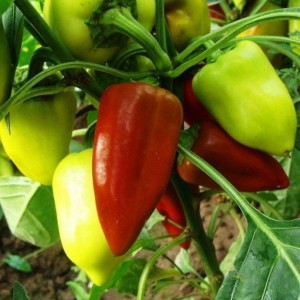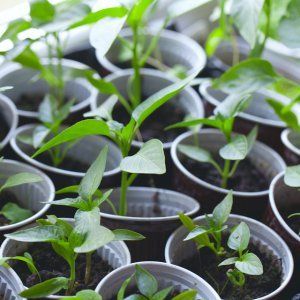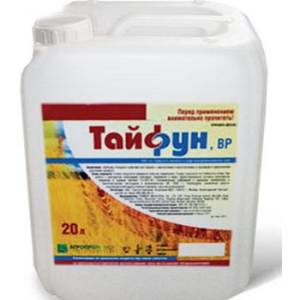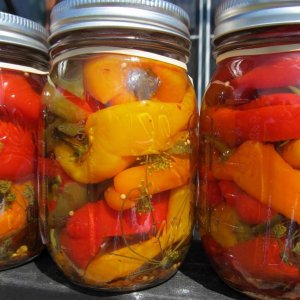How to grow pepper Tenderness, time-tested and loved by gardeners
Pepper variety Tenderness is one of the most beloved among gardeners. The vegetable got its name due to its juicy pulp and pleasant taste. Pepper is used in cooking and folk medicine, healthy vegetable salads are prepared and frozen for the winter.
It is easy to grow pepper, the main thing is to follow simple agrotechnical rules and closely monitor the growth of the plant. Let's take a closer look at what Tenderness pepper is and how to get a rich and tasty harvest.
The content of the article
What kind of pepper is this
 The vegetable has long been known among summer residents - the variety began to be grown more than 30 years ago. Basically, it is planted in greenhouses and hotbeds, but in the southern regions Tenderness takes root in the open air.
The vegetable has long been known among summer residents - the variety began to be grown more than 30 years ago. Basically, it is planted in greenhouses and hotbeds, but in the southern regions Tenderness takes root in the open air.
The variety is early maturing, the first harvest is harvested by gardeners after 100-110 days from the moment of planting. The bushes are medium in size, reaching a height of 80-90 cm. During the fruiting period, plants need a garter, since under the weight of the fruit they can break.
Pepper is resistant to pests and crop diseases.
Fruit characteristics and yield
The fruits are smooth and even, cylindrical in shape (see photo). The weight of one pepper varies from 90 to 100 g. Wall thickness - 8 mm, color - deep red.
Due to its medium size and tasty pulp, Tenderness is often used in the preparation of winter snacks and salads. Gardeners remove about 2 kg of beautiful and mouth-watering fruits from one bush.
Preparation for growing
To get a good harvest, summer residents prepare seedlings in advance. Its quality depends on seeds and soil.... Seeds of the Tenderness variety are purchased in shops for the garden. Summer residents are advised to buy material only in proven places, when buying, study the expiration date and planting recommendations. At home, inspect the seeds for damage, throw out all defective specimens. Disinfect the remaining seeds in a solution of succinic acid or manganese. Some summer residents trust only professional products and disinfect seeds with Maxim.
Important! In order for the seeds to quickly adapt to external conditions, they are germinated. To do this, the disinfected inoculum is wrapped in slightly damp gauze and placed in a warm place. Germination strengthens the plant's immunity and reduces the risk of disease.
Particular attention is paid to preparing the soil for seedlings. The earth should be nutritious and airy. Some summer residents use soil from the garden, having previously cleared it of debris and insects, while others prefer soil from a store.
In both cases, it is better to disinfect the soil yourself by placing it in the oven for 40-50 minutes. To improve the quality, peat or humus is added to it, as well as a natural baking powder - refined river sand.
Planting seedlings

Seedlings of the Tenderness variety are prepared in late February - early March. Pepper is planted in any container, for example, in plastic cups, flower pots, wooden boxes. The main thing is to thoroughly rinse the container before planting and disinfect it with manganese. Earth is poured into the container, small pits are made with a depth of 1-2 cm. Two seeds are placed in each, sprinkled with earth on top and poured abundantly with warm, settled water. The next watering is organized only after 7-10 days.
Grow Tenderness on a sunny windowsill.If the weather is cloudy outside, the seedlings will be provided with additional illumination with fluorescent lamps or phytolamps. Lack of light leads to the fact that the leaves and stems of seedlings weaken and stop growing.
Moisten the peppers as the soil dries, about once every 5-6 days. It is advised to use a pipette for watering. The optimum water temperature is 18-20 ° C.
Important! Fertilize seedlings every two weeks. Peppers are positively influenced by feeding with ash, iodine, ammonium nitrate. Summer residents alternate mineral complexes and organic matter so that plant nutrition is consistent and balanced.
If the pepper is planted in small containers, it should be dived after 2-3 weeks. Picking is the process of transplanting seedlings in a larger container. Over time, the roots need more space to develop, otherwise the seedlings will stop growing. However, experienced summer residents advise planting the vegetable immediately in a large container, since during the picking process, thin and fragile roots can break.
Planting pepper in the beds
Before planting seedlings in the garden, the beds are dug up, cleaned of debris and fertilized with peat. The first digging will be organized in October, before the snow. The beds are re-prepared directly 10-15 days before disembarkation.
It is better to plant a vegetable after onions or legumes. It is not recommended to use potato or tomato beds for peppers.
Since Tenderness is a greenhouse variety, the walls of the greenhouse are wiped with a solution of Bordeaux liquid in order to protect the pepper from weeds and insect pests.
In the beds, recesses are made at a distance of 20-30 cm from each other. The seedlings are carefully removed from the container and placed in the ground. Before transplanting, the seedlings are watered so that the bushes can be easily removed from the container. When the sprout is in the garden, the stem is sprinkled with soil from all sides and again watered abundantly. A wooden peg is installed next to each bush in advance - it will be needed to tie the bushes.
Plant care
When growing crops in a greenhouse, the structure is regularly ventilated. If this is not done, the heat and humidity will lead to fungal infections and infections. Water the pepper as the earth dries up, about once every 4-6 days. One bush consumes 1.5-2 liters of water.
Periodically, the usual watering with water is replaced by feeding with solutions of nettle or burdock. These folk remedies improve the taste of fruits and protect plants from negative factors. It is better to moisturize the beds in the early morning to avoid sunburn.
In addition to moisturizing, pepper needs additional feeding. Potassium-phosphorus compositions and wood ash have an excellent effect on bushes. They are applied 2-3 times per season before watering. In addition, manure and bird droppings are recognized as excellent fertilizers. They strengthen the root system, especially if applied during flowering or fruiting. Before the procedure, the soil is loosened and weeds are removed.
Features of cultivation and possible difficulties
When applying dressings, be sure to follow the dosage and recommendations. An excess of minerals leads to the fact that the leaves turn yellow and dry out. Abundant irrigation helps to correct the situation, which leaches minerals from the ground. Wood ash also fights the problem well. Experienced gardeners are advised to always keep a supply of ash with you, as it is recognized as an effective solution to many problems.
During the fruiting period, the bushes of the Tenderness variety are tied to a support. Wooden stakes are disinfected in advance with manganese, clean strips of fabric are prepared. It is best to use plain cotton as synthetics are slippery and often come loose. The fabric is carefully wrapped once around the stem and a knot is tied on the peg. Under no circumstances should the knot be tightened tightly, as the stem may break.
Typical diseases and pests

Colorado beetles are sometimes found in the beds with pepper. Insects hide deep in the soil in winter, with the arrival of heat they appear on the bushes. Both adult striped pests and their larvae are dangerous. Beetles eat the leaves, taking from the plant the minerals and vitamins necessary for development. If you do not take action, the pepper dies. To fight the beetle helps the drug "Typhoon" or spraying the beds with a solution of copper sulfate.
They love to feast on pepper and slugs. Unpleasant and slippery insects suck sap from plants, thereby disrupting metabolism. In the fight against them, spraying with a special solution helps: 15 drops of iodine and 0.5 liters of milk per 10 liters of water.
Of the diseases, gardeners note late blight, which appears due to heat and high humidity.... A sign of late blight is brown spots on the leaves. In the fight against the fungus, whey or the drug "Oxyhom" helps. Also, sometimes the pepper gets sick with tobacco mosaic. The virus appears as a yellow pattern on the leaves. Treat tobacco mosaic with saline or manganese.
Advantages and disadvantages of the variety
The main advantages of the Tenderness variety are attractive red fruits and juicy sweet taste. Housewives actively use the vegetable for cooking: soups, side dishes, salads and preparations for the winter. Pepper has plasticity and elasticity, it makes delicious crunchy snacks.
The vegetable contains a large amount of vitamins and minerals that have a positive effect on human health and prevent many diseases. Pepper Tenderness is easy to care for and unpretentious to grow. Thanks to its thick walls, it can be stored well and can be transported over long distances.
Of the shortcomings, the need for a garter of bushes is noted. Novice gardeners sometimes have difficulties with this procedure. Also, the variety Tenderness is best grown in a greenhouse, and not outdoors. In this aspect, it loses to those peppers that show excellent results in any conditions.
Reviews
What do experienced gardeners and novice farmers say about Bulgarian Tenderness pepper? Consider a few reviews about the variety.
Galina, Voronezh: "I grow 2-3 varieties of pepper in my garden every year. Last season, Tenderness planted and was satisfied. Red bright peppers look beautiful both on the bushes and on the table. The taste is excellent, there are few seeds, an ideal variety. "
Marina, Moscow: “I have been growing 'tender' peppers for the seventh year now, and each time a new crop is better than the previous one. The whole family loves to eat fresh vegetables or prepare snacks for the winter... The plants never got sick, they did not cause trouble in care. I recommend for growing. "
Peter, Saratov: “I got the seeds, on the packaging the manufacturer recommended planting the vegetable in the greenhouse. I decided to plant with seeds, without seedlings. As a result, the fruit tied badly, grew thin. I collected only 1 kg from one bush. The variety did not impress. "
Read also:
How to cook pickled hot peppers for the winter without sterilization.
Conclusion
In order for the Tenderness variety to please with a rich harvest, gardeners are advised to plant it in a greenhouse or greenhouses. The heat-loving vegetable is fertilized with minerals and organics, which improve the taste of the pepper and saturate it with useful elements.
Fruits are harvested in August, when they turn red and become firm. The vegetable is consumed fresh or processed: frozen for the winter and canned.